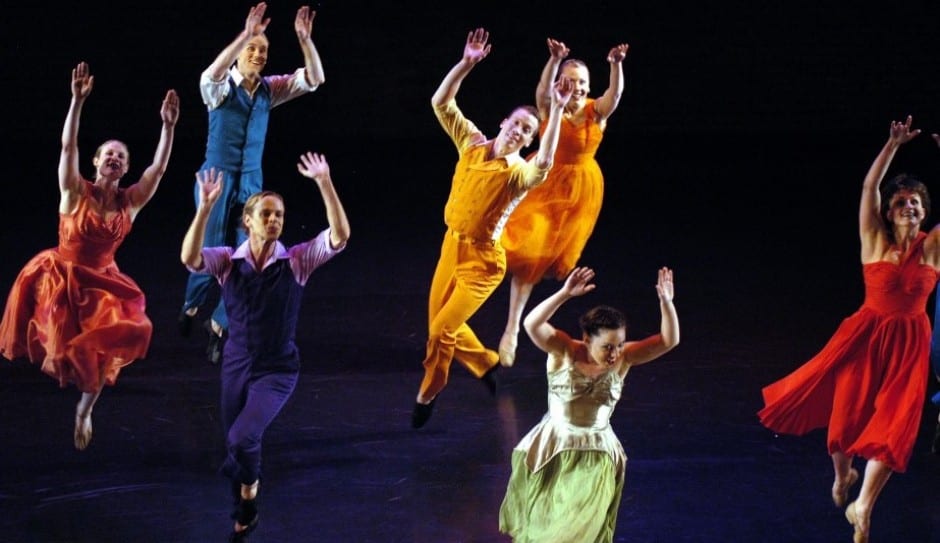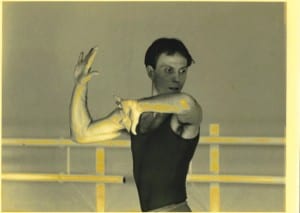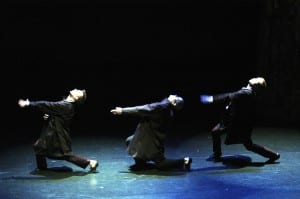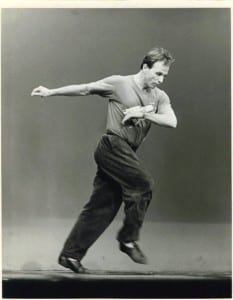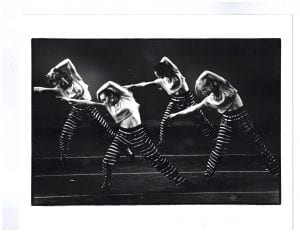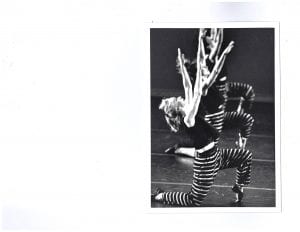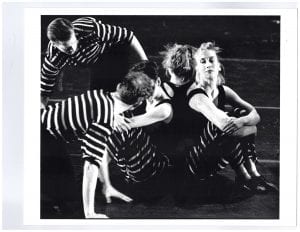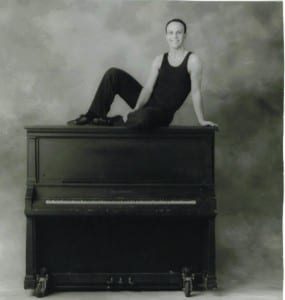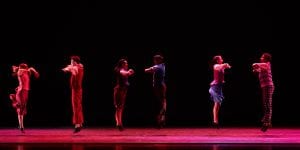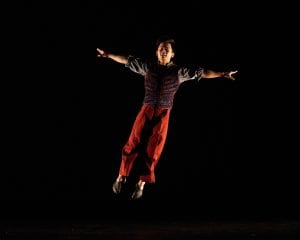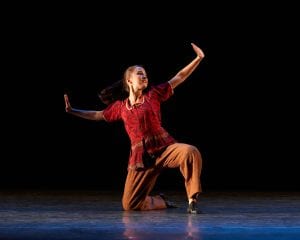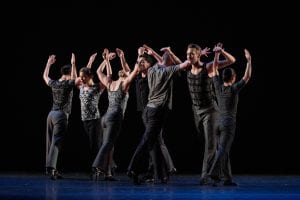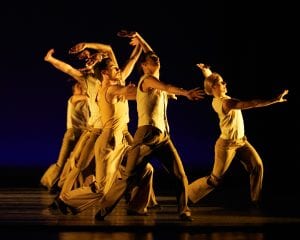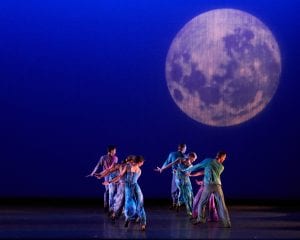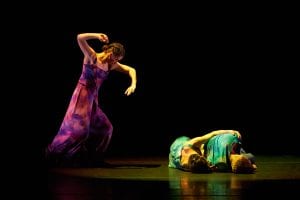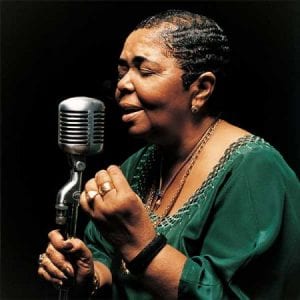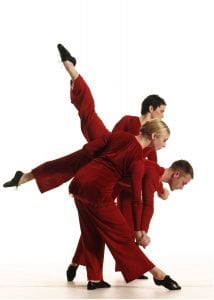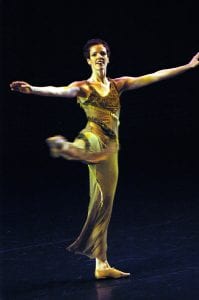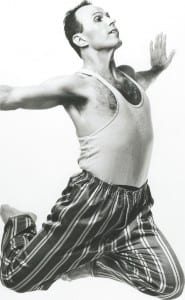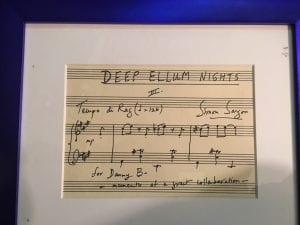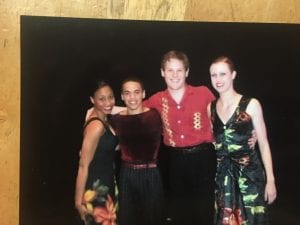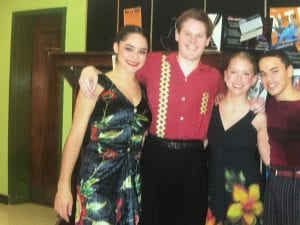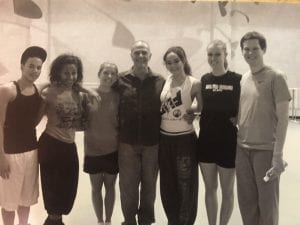What follows is a list of all the dances I have created beginning in 1979 continuing on to 2015. A second list will document all dances done with an original music score and a third, work conceived with original set design . A personal list of what are called “Signature Works” and lastly a group of dances that one could say never quite worked.
1979
Swing Suite – Glenn Miller & the Army Air Force Band
Tumbleweeds – Linda Ronstadt, Tammy Wynette, The Doobie Brothers
Wolf Eyes – Tom Waits, The Paul Winter Consort
Dead Heat – Gino Soccio
1980
Promenade – George Gershwin
52nd Street – Billy Joel
An American in Paris – George Gershwin (The Richmond Ballet commission)
1981
Fission – The Dave Brubeck Quartet
Relight My Fire – Dan Hartman
Moonbath – Mikko Mikkola
SPLASH – The Lions, Bobby Vee, Chubby Checker, Leslie Gore, Joan Jett, The Silicon Teens, Finn and the Sharks
1982
On the Side of Light – Eric Valinsky (American Dance Festival commission)
Goose Pimples – Bix Beiderbecke
Easy – Kevin Gruden
1983
Quitting – Scott Joplin
Been in the Storm Too Long – Traditional Spiritual
1984
Reach Out! – The Four Tops, The Supremes, Marvin Gaye & Tammy Turrell, Martha and the Vandellas
1985
AVALON – Lionel Hampton (Jacob’s Pillow commission)
Gone – Juan Tizol
Lost Life (Four Scenes from the Life of Art Papper) – Art Pepper
1986
Rhapsody:The Skyscraper Observed – George Gershwin
Wind Waltzes – The Dave Brubeck Quartet
Tanguedia – Astor Piazzola (Zenon Dance Company commission)
1987
Soulo – Willie Ruff
1988
Out of the Blues – Amy Duncan (original score)
Pithecanthropus Erectus – Charles Mingus
Night Vision – Astor Piazzolla
Impending Bloom – Oregon (Zenon Dance Company commission)
1989
Merry Go Round – Glenn Miller and the Army Air Force Band
Monkish – Thelonious Monk (Harvard Summer Dance commission)
Blue on the Moon – Sidney Bechet
1990
Racing the Wind – Egberto Gismonti
Ancestral Voices – Bulgarian Women’s Choir
1991
Airegin – Lambert, Hendricks and Ross
1992
Secular Psalmody – Sister Rosetta Tharpe, Randy Newman, Archie Shepp
‘Tis the Season, Ellington Nutcracker – Duke Ellington
1993
Le Souvenir (For All We Know) – Sung by Lillian Boutte
Fuerza Viva – Tito Puente, Celia Cruz
On My Way – Mahalia Jackson
1994
Swing Concerto – Brave Old World, Artie Shaw, Louis Prima/Bennt Goodman
1995
Les Exiles – Kurt Weil
1996
By the Horns – John Faddis (Boston Ballet commission)
1997
Bone Matter – Walter Paige
Among These Cares – Sir Roland Hanna (Library of Congress commission)
Cortege – Wynton Marsalis – commissioned by the Meadows School of the Arts – SMU
1998
Foot Fetish – Julia Lee, Lillian Boutte, Slim Gaillard (University of Minnesota commission)
Points on a Curve – Ornette Coleman, Terumasa Hino, Masabumi Kikuchi)
Scene Unseen – Billy Staryhorn, Duke Ellington
Cortege – Wynton Marsalis – extended version created on JAZZDANCE
1999
21st Century Stride – Peter Jones (Original Score – Commissioned by JAZZDANCE)
Ezekiel’s Wheel – Philip Hamilton, Peter Jones (The Bates Dance Festival (Maine) the Walker Art Center (Minneapolis) commission
2000
Jump for Joy – Benny Goodman (The Richmond Ballet commission)
2001
COPLAND/Music & Imagination – Aaron Copland
Song Awakened – Cesaria Evora
2002
BEAT – Philip Hamilton (The Joyce Theater and The Flynn Center for the Performing Arts – Vermont commission)
Tango Etudes – Muhlenberg College Dance Division (Pennsylvania) commission
Las Cuatro Estaciones – Astor Piazzolla
2003
GET HAPPY (The Judy Garland Project) – sung by Judy Garland
Stomp, Look & Listen – Duke Ellington George Mason University (Virginia) commission
2004
True Believer – Ofdetta
Together in Time – Reverend Cleophus Robinson, Mahalia Jackson, Columbia College (Chicago) commission
2006
Ancestral Voices – Virginia Rodrigues (Southern Methodist University)
2007
Evidence of Things Unseen – Bill Evans, Don Pullen (Zenon Dance Company (Minneapolis) commission
UMBRA – Duke Ellington (Southern Methodist University)
2008
Elegant Echoes – Jelly Roll Morton (Zenon Dance Company ( Minneapolis) commission
2009
Deep Ellum Nights – Simon Sargon (Southern Methodist University)
Deep Ellum Nights is a score by Simon Sargon. Simon taught music composition at SMU for many years. He felt that the score was very “dancy” and asked if I might be interested in choreographing it. I was and I did and it turned out very well. The first section payed homage to Lilac Garden a work by one of my favorite ballet choreographers, Sir Anthony Tudor.
The cast included Lee Duveneck, Jasmine Black, Albert Drake, Rachel Trippet, Vanessa Trevino and Katie Castellucci.
2010
An American in Paris – George Gershwin (Southern Methodist University)
2013
In the City – Leonard Bernstein (Southern Methodist University)
Dances Choreographed to an Original Score
Moonbath (1981) Mikko Mikkola
On the Side of Light (1982) Eric Valinsky
Soulo (1987) Willie Ruff
Out of the Blues (1988) Amy Duncan
Among These Cares (1997) Sir Roland Hanna
21st Century Stride (1999) Peter Jones
Ezekiel’s Wheel (1999) Philip Hamilton/Peter Jones
BEAT (2002) Philip Hamilton
Dances with Original Set Design
SPLASH (1981) Danny Buraczeski
Reach Out! (1984) Danny Buraczeski
Rhapsody:The Skyscraper Observed (1986) Mark Beard
Soulo (1987) Susan Weil
Ancestral Voices (1990) Susan Weil
‘Tis the Season (1992) Alex Jankowski
On My Way (1993) Susan Weil (set designed originally for Soulo)
Among These Cares (1997) Susan Weil
Las Cuatro Estaciones (2002) Susan Weil (set originally designed for Ancestral Voices)
Certain dances in a long choreographic career can be what is called, SIGNATURE WORKS. These are works that define an artist’s aesthetic and point the direction forward. These, I would consider mine.
Fission (1981) The Dave Brubeck Quartet
Lost Life (Four Scenes from the Life of Art Pepper) (1985) Art Pepper
Avalon (Commissioned by the Jacob’s Pillow Dance Festival 1985) Lionel Hampton, Benny Goodman
Blue on the Moon (1989) Sidney Bechet
‘Tis the Season – The Ellington Nutcracker Duke Ellington (1992)
On My Way (1993) Mahalia Jackson
Swing Concerto (1994) Brave Old World, Artie Shaw, Louis Prima/Benny Goodman
Ezekiel’s Wheel (1999) Philip Hamilton, Peter Jones
COPLAND/Musc & Imagination (2001) Aaron Copland
Song Awakened (2001) Cesaria Evora
GET HAPPY (The Judy Garland Project) (2003) music sung by Judy Garland
In the City (2013)
This final list are dances better forgotten, although I do think that mistakes have great value if you can learn from them. At best, these were ill-conceived.
52nd Street (1980) Billy Joel
Moonbath (1981) Mikko Mikkola
Easy (1982) Kevin Grudin
Been in the Storm Too Long (1983) Traditional
Night Vision (1988) Astor Piazzolla
Ancestral Voices (1990) Bulgarian Women’s Choir (Zenon/JAZZDANCE)
BEAT (2002) Philip Hamilton
Ancestral Voices (2006) Virginia Rodrigues (SMU)
That makes 8 out of 65 dances, not too bad. Actually, I think dances better forgotten is a bit harsh – maybe dances that never worked might be a better way to describe this last list.
Signature Works
Fission (1981)
Fission is the dance that truly set me on the path of working with jazz in a personal and distinctive way. Dave Brubeck was my introduction – the rhythms, the melodies and the feeling drew me in. I had been reading a lot of Beat poets – Jack Kerouac, Allen Ginsberg and Lawrence Ferlinghetti in particular. I picked Take Five, Upstage Rhumba, Blue Shadows in the Street, Unsquare Dance, Far More Drums and Sixth Sense as the musical roadmap. The music had a compelling “coolness” to it. I wanted to create a “jazz dance” that developed its feeling and impact based on the relationships among the dancers. I wanted the audience to watch the dancers relate to each other, not to the audience. I read a lot about the early 1950’s, post-World War II America. When the soldiers returned home, they found that things were different. Women had gone into the workforce and had taken on new responsibilities. There was often tension and a bit of “Fission” (splitting apart) between men and women, husbands and wives, boyfriends and girlfriends. I created arms and hand moments that didn’t quite stretch out to their max. The ending of Take Five has the dancers facing each other, arms extended, splitting apart and dropping to the floor. The structure of the dance reflected the same ideas, men and women danced together in the first section and not again until the finale. In between, there were four trios – men, women, men women. It was very exciting for me to work on specific ideas that were embedded in the musical choices. The dance has a very specific feeling.
Lost Life (Four Scenes from the Life of Art Pepper) (1985)
A beautiful dance, I think, adult subject matter and an attempt to portray women in the jazz idiom as real human beings, not street walkers, not prostitutes, not temptresses. It is still amazing to me that jazz artists who play the same instrument have such distinctive sounds. It is certainly the unique quality of very human breath. Listen to Lester Young, John Coltrane, Stan Getz, Ornette Coleman – they sound only like themselves. Art Pepper played alto saxophone. His sound was described as lyrical yet his life was anything but. He had a major heroin addiction and was incarcerated numerous times. I based the dance on Art Pepper’s biography, Straight Life and a documentary made by his wife Laurie. It is called Art Pepper: Notes from a Jazz Survivor.
The dance has only five characters, Art Pepper as a boy, his mother, Art Pepper as a man, his wife and the Dealer. There are four sections set to the beautifully lyrical Winter Moon, an amazingly fast bebop piece, Art’s Oregano, The Trip and Lost Life.
Avalon (1985) Commissioned by the Jacob’s Pillow Dance Festival)
Avalon was not on my initial list of signature works. This video excerpt is from a performance at the Joyce Theater as part of their first Joyce Sampler. I was digitizing FISSION from this performance and thought I would watch Avalon. I hadn’t thought about it in a long time. I think it is delightful. It has great structure, lots of movement ideas and it is so very, very physical. I am putting it on the list of signature works for those reasons and because it represents the beginning of my taking what I learned from Betsy Haug and making something of my own out of all that wonderful movement knowledge. The music is played by Lionel Hampton. There are three sections set to Avalon, Ham Hock Blues and Air Mail Special.
Blue on the Moon (1989)
The original version of this dance was created on the NYC based JAZZDANCE. The final version was completed while I was at Zenon in Minneapolis. This was one of three dances we toured in Swtizerland. The other two were Fission (Brubeck) and Lost Life (Art Pepper) – great program – jazz heavyweights – abstraction, dance biography ands a celebration of classic jazz dances – what could be better! The dance is set to the wonderful music of Sidney Bechet. I called it Blue on the Moon because the music has an earthy and at the same time, beautifully unearthly quality. He played both clarinet and soprano saxophone. In 1919, Swiss conductor Ernest Ansermet wrote that Sidney Bechet’s clarinet playing was “perhaps the high-way the whole world will swing along tomorrow”. The dance was an immersion into Bechet’s musical world and a celebration of the vernacular. His playing employed growls, moans, plaintive calls, luminous high tones and whispered asides. This is exactly the kind of language I use when I teach. Blue on the Moon acknowledged classic jazz dances like the Cakewalk, Charleston and Blues dancing.
On My Way (1993)
This was the first major work I created on the new JAZZDANCE in Minneapolis and was the centerpiece of the debut concert. Set to the glorious singing of Mahalia Jackson, making this six section dance was a true tonic to the difficult time I had just gone through severing my ties with Zenon and re-establishing an independent voice in the Twin Cities. These are the songs: How I Got Over, In the Upper Room, Trouble of the World (Mahalia Jackson sang this at the end of Douglas Sirk’s film remake of Imitation of Life), Keep Your Hand on the Plow, Joshua Fit the Battle of Jericho, and On My Way. I teach an extended excerpt of In the Upper Room in my more advanced classes at SMU and I have also taught the solo Joshua Fit the Battle of Jericho. It is challenging material.
‘Tis the Season/ The Duke Ellington Nutcracker Suite (1992)
I created the first version of this dance while I was at Zenon. It was an intense collaboration with set designer Alex Jankowski whom I had met in Memphis, Tennessee. We collaborated on a site specific “pageant” called PAX performed outdoors at the Memphis Art Institute. The costume designer was James Viera. I first met Jimmy in Boston. I was invited to choreograph a work for a dance community AIDS benefit called Rhythms of Hope. He has a boundless imagination, one of the most resourceful and life affirming people I have ever met. Duke Ellington recorded the music in 1960. The 1960’s was the inspiration for both the sets and costumes. Acknowledging Tchaikovsky, I used the traditional Nutcracker overture as the overture. There is a huge gift box on stage. The family is introduced. The living room is inside the box, pop-up furniture, and the family builds it in front of the audience. Pop-up books of all kinds were popular in the ’60’s. The doorbell rings and the party guests bring an oversized television set as a gift. Clarisse (Clara) turns it on and it comes to life. The “magician” appears. I am the only person who has danced this role and conceived it as a glittery car salesman. He hypnotizes everyone, puts Clarisse inside the TV and takes her to a magical place “inside the TV”. The idea was that with the introduction of the television set into the American home, people were able to go places the’d never imagined before. All of the variations are based upon popular culture of the times. It begins with tapping Christmas trees, followed by a duet with a huge physioball – Chinese Checkers. There is a duet for Barbie Ballerina and Mr. Potato Head and a Waltz of the Flowers with huge fashion hats (Audrey Hepburn) and a feisty bee. Next is a sexy duet that begins inside a huge lava lamp. There is then an apotheosis. I used music from Edward Scissorhands composed by Danny Elfman for the farewell. It is beautiful and emotional and the perfect bookend, I think to the opening Tchaikovsky. The variations say farewell as it snows. The magician thanks them, puts Clarisse back inside the TV and returns her to her living room. He disappears and the television screen goes snowy and then goes dark. The work is fanciful and has, I think, a great sense of humor. The entire Nutcracker, sort of, in under 50 minutes. Referring back to the Pre-History page, my first professional appearance was in the Pennsylvania Ballet’s Nutcracker at the Academy of Music in Philadelphia. I was the Bear!
Swing Concerto (1994)
Swing Concerto was created in 1994 in Minneapolis, second year into the newly reborn JAZZDANCE. It is the dance I have frequently set on other companies, in colleges and universities. I often think of it as my own Esplanade, if that is not too presumptuous. I did a Swing piece in my very first concert, New York – 1979. It was called Swing Suite, set to music by Glenn Miller and the Army Air Force Band. This was some of my parents’ favorite music. My father was a paratrooper in World War II. The dance honored their love of swing dancing together. The costumes were khaki and white.
I thought it was time to once again look to the Swing Era as inspiration for a new dance. I bought and listened to countless CD’s – nothing was happening and we had to do the premiere in our April 1994 O’Shaughnessy Dance Series appearance. Dan and Margaret Shulman, both attorneys, were great supporters of my work. Dan had a huge jazz collection and left the door to their home open for me to stop by and explore. I did. Judith Brin Ingber, another friend and dance scholar told me to get out of the house. There was a festival of Israeli folk music and dance at the Minneapolis Jewish Community Center. We went together. Curtain lifted, first thing on the program was Brave Old World, a Klezmer band playing live. Lightbulb! I had been listening to a lot of Artie Shaw, courtesy of Dan Shulman and the Klezmer band reminded me of a piece called Concerto for Clarinet. I went back and listened to it again and Swing Concerto was born.
The dance that developed became an exploration of the relationship between two glorious vernacular traditions, Eastern European Klezmer and the swing orchestras of Artie Shaw and Benny Goodman. Both Shaw and Goodman were Jewish and rediscovered their ethnic roots after hiring Jewish emigres to play in their bands. There are two sections of Klezmer leading into the Artie Shaw. This was Clarinet Concerto, created for a hollywood film but never used. The success of the dance was in the transition from Klezmer to jazz. The Shaw did just that. The finale is a wonderful version of Sing! Sing! Sing!, Louis Prima/Benny Goodman, from the soundtrack of the film Swing Kids.
Personal Observations – We got into the theater with Swing Concerto. It was dress rehearsal and I was not happy with the ending. I came up with what I thought would be a smashing new ending. I taught it to the dancers in the Green Room. It was smashing and usually brings audiences to their feet.
Judith Brin Ingber looked at the dance and told me what I had created often recalled the way the male Hasidim danced. There was one step she called “looking for God’s address”. So it is.
In thinking about the opening solo, I was listening to the music while I was shaving. I experimented with the head “bumps/accents” looking in the mirror. i think it has a strong link to what was called “eccentric dancing” in black vaudeville. Les and I were living on the top floor of an apartment on Lagoon Avenue in Minneapolis, directly across the street from the great Lund’s grocery store. It is also where I recuperated from my first knee surgery.
At Jacob’s Pillow, we showed sections on the Indoor/Outdoor stage. I asked the audience if they knew what Klezmer music was. An elderly woman described it as Jewish soul music an said, I quote, “A wedding without Klezmer is like a funeral without tears.” Need I say more?
Ezekiel’s Wheel (1999)
I love this dance and I love the fact that I had almost a year and a half to create it. Ezekiel’s Wheel is inspired by the life and work of African American novelist, essayist and Civil Rights activist James Baldwin. Many people suggested that I seek out composer and vocalist Philip Hamilton. They said we would be great collaborators. Apparently, people told him the same about me. At last, one summer at Jacob’s Pillow, Philip arrived to accompany Judith Jamison’s Master Class. I watched him play, he watched me teach and we agreed that all those people were right. I asked if he might be interested in creating something in honor of James Baldwin. We decided to reread as much Baldwin as we could and then talk. We identified what we called the Three R’s of James Baldwin, Recognition, Responsibility and Redemption. We would build our collaboration around these themes. Ezekiel’s Wheel was commissioned by the Walker Art Center (Minneapolis) and the Bates Dance Festival (Maine) with additional support from the John S. and James L. Knight Foundation, the New England Foundation for the Arts and the National Endowment for the Arts. The dance has six sections and is thirty minutes long. There is spoken text with James Baldwin reading the eulogy from his novel, Another Country and another short recording taken from an appearance on the Jack Paar show. Among the eight dancers is a soloist, an individual deciding to take on great loss and pain on behalf of everyone. It was created on Jennifer Wolverton (Stringer). She had great strength but also an extraordinary vulnerability. When I restage the work, I always see Jennifer. I talk about the role being “transparent”, as Jennifer was naturally -beautiful.
The opening statement is one of solidarity, a group with determination and purpose – a group Recognizing that something in the world needs to change. I looked at lots of photo anthologies of the Southern Civil Rights Movement and drew upon images of the linked arms and body language of the marchers. The eulogy is next, a solo, followed by an extraordinary Blues section written by Peter Jones in collaboration with Philip. It is the group. The soloist enters at the very end of this section, again dances alone and then takes on the 7’s, a long and musically challenging section in 7. The ensemble enters and exits twice. These three movements reflect the Responsibility theme. With the second Baldwin text and the finale, the Anthem of Hope (my words), we have Redemption. When the dancers walk on in this section, I suggest that the air is fresh, new and fragrant. The world has changed for the better. Near the very end, about 28 minutes into the dance, three images appear slowly behind and above the dancers’ heads. It is a slow reveal, looking like a cloud at first then coming into focus as photographs of Civil Rights activists, arms linked together. I waited until the last moment, hoping that the accumulation of dance imagery up to that point would make this an emotionally rich moment for the audience. I am very proud of Ezekiel’s Wheel. Jennifer Dunning’s review in the New York Times was titled – A Jazzy Form Reinvented as a Meditative Balm. Wow – she got it – yet again.
Some Stories Having James Baldwin’s voice in EW, incorporated into the score, gave the work its heart. It was a happy accident. I had finished choreographing the opening section and was ready to move on. We were scheduled to do a preview of the new dance at Jacob’s Pillow in July 1998. There was a lot of pressure. I thought I had found everything by and about James Baldwin at the Minneapolis Public Library. I was wrong. While waiting for the music, I found audio cassettes of Baldwin reading his own work. It was so powerful and so beautiful. I knew it had to be incorporated into the dance. I had never choreographed to text and was a bit nervous. I had a talk with Erin Thompson. She and her husband Byron Richard had used a lot of text in their work. Erin gave me a great book called Art and Fear. I went into the studio and approached the text as music. It worked out. There is a moment in the solo when the dancer, responding to James Baldwin saying, “someone we loved, is dead” clasps her hands together, enclosing a spirit. She rubs her hands together, develops some warmth, opens them and lets it go as she falls backwards. I must say thank you to choreographer Kei Takei. I took a master class with her when she was in the Twin Cities performing part of her Light series. One of the first things we did was rub our hands together and let our individual spirits out into the room. You never know, I suppose. Thank you.
COPLAND/Music & Imagination (2001)
I have always been interested in composers who were profoundly influenced by jazz music. Aaron Copland is the quintessential American composer. He embraced jazz . I created an hour long work in honor of the 100th anniversary of his birth, designed for the Southern Theater in Minneapolis.It was called COPLAND/Music&Imagination and it was a challenge. I would say that the company at this point was at its most cohesive and expressive both individually and as an ensemble. This work was both a celebration of Aaron Copland and the artists of JAZZDANCE.
It began with some short pre-recorded text, a poetic assessment of Copland’s work, flowed by a solo to the waltz from Billy the Kid. The group entered at the end of the solo and everyone danced to one of the American Songs, Long Time Ago sung by the Morman Tabernacle Choir – yes, the Mormon Tabernacle Choir! . This seamlessly went into a series of spare, dynamic and moody piano pieces, Four Piano Blues. continuing on to a section of the fiendishly difficult Clarinet Concerto. There was a dramatic and emotional duet for two women set to two sections of Sonata for Violin and Piano. The dance closed with the majestic Quiet City. Jeff Bartlett did some of his most exquisite lighting and Mary Hansmeyer, once again, outdid herself with spot on costume design.
One Story COPLAND/Music&Imagination was created in 2001, twenty-two years into my history as a choreographer. Never in all that time did I have any problems with the rights to the music I used. The Copland evening got lots of press and great reviews. I got a call one afternoon from Boosey & Hawkes, the music publishing house that licenses all of the music. They were delighted that my evening was such a success. I would have to pay fees for all the music I had used. This was a first. They have a formula based on the number of performances and the size of the theater and audience capacity. They came up with a fee, around $2000 that I paid over time using a reasonable payment plan. Caught!
Song Awakened (2001)
I created this work after a summer visit to Cuba, studying Afro-Cuban Folkloric and Cuban popular dances. This was made possible by a Travel & Study Grant, another of the great opportunities Twin Cities foundations make available to its artists. I flew from Mexico to Havana on an old Russian passenger jet. This was all possible because it was a trip sponsored and organized by a SanFrancisco based cultural exchange program. In addition to our classes in dance and music, we had lectures about public health in Cuba, economics and agriculture. We saw a film by Estella Bravo about Fidel Castro at a very fancy hotel in downtown Havana. We also had a bus trip to an agricultural co-operative about one hour east of the city. I actually got to walk around a sugar cane field. My favorite place of all was the Embarcadero, a sea wall of sorts where on could walk along the edge of the harbor downtown. You could almost see Miami. I had never spent time on an island which was not a vacation spot. A highlight of the trip was getting to see the Buena Vista Social Club at the Karl Marx Theater. This was their first visit back to the island after their huge success around the world. The theater was packed and was wild. I saw Ruben Gonzales, Omara Portuondo and Ibrahim Ferrer. I think the ticket cost $10!
I heard and bought a lot of incredible music while in Cuba and wanted to create a dance based on my experiences there. I decided to create a work about the sea and used music sung by Cesaria Evora. She is from Cabo Verde and sings in Portuguese in a style called Morna – often described as Creole Portuguese Soul. Her music is about longing and the melancholy of being separated from the home and people you love. A duet and a sliver of a moon began the work. It was really a folk tale and, being about the sea, I decided to have no entrances or exits on the diagonal, they were all from right to left. There was a central couple and a group. It was about bringing them back together as a community which didn’t happen until the finale under a full moon. It is a dance that is very special to me.
GET HAPPY/The Judy Garland Project (2003)
This hour long tribute to Judy Garland was a true labor of love. It was created specifically for the Southern Theater in Minneapolis. Growing up, I was obsessed with the Judy – Live at Carnegie Hall album. Not only was the singing breathtaking – risky and raw, the response of the audience was electric from beginning to end. The choice of songs and how they were put together to make a “score” was critical. I could say this of all my dances but in this case it was even more so.
The theater went dark and Judy sang, Tonight When We Were Young. There was a musical cross fade into the audience applauding in anticipation of Garland’s entrance. I wanted to capture that building momentum, almost hysteria, by having the dancers enter running, changing directions, having near misses until they stopped. While this was happing a “Judy” figure walked slowly from up to down stage. Different dancers represented her in different sections of the dance. When they did, they wore a red scarf. All the costumes were in black and white like the Wizard of Oz. The next section was Alone Together. In the dark, you heard voices chanting – Judy, Judy – Judy Judy. the lights came up on me. I wrote text about my love affair with Ms. Garland and I danced to the text (again, EW). This lead into Zing Went the Strings of My Heart.
A group section to If You Feel Like Singing followed, the By Myself with a solo figure being applauded/stalked by a group moving in a complex rhythm. The beautiful Then There Was You was a duet suggesting Judy and her father. We then went to Hollywood with Mickey and Judy dancing to The Texas Tornado. This was about working for the sadistic Busby Berkley. I had the song edited so that it stopped when a figure yelled “CUT”. The dance resumed from the beginning, a bit longer and another “CUT”. At the end, the two dancers collapsed from exhaustion. Then There Was You repeated, this time a trio, suggesting Judy and her two children. After this, I just had to take on The Man That Got Away. It suggested a sexy smoky bar, perhaps a gay bar. I love this section.
Preparing for the end, I again used the song Last Night When We Were Young. This was the ‘Overture” to the whole evening. The dancers ran on upstage from right and left, paused and started to move forward in slow motion. Downstage, we had placed poppies and as they walked through them, they began to fall asleep. The theater went dark, slowly a mirror ball began to rotate and gently bring everyone back to life, all except one dancer. Everyone just stood and watched as the lights faded. Another voice over taking about the accidental overdose and details of Judy Garland’s remarkable career. The lights came up and I did another gentle solo to an unusual song, Yours and Mine. The finale was GET HAPPY. It was in technicolor and a great celebration.
There is so much in this dance, an abundance of love and research, the well known and also not well known music of Judy Garland. I think it is theatrically innovative and emotionally engaging work of biographical jazz dance theater – excellent!
In the City (2013) Southern Methodist University
I finally made a dance at SMU that felt like the dances I made when I had my own dance Company. Every three years the Division of Dance at SMU collaborates with the Meadows Symphony on a program at the Winspear Opera House in the Dallas Arts District. It is a major fundraiser for scholarships. Paul Phillips is the music director and conductor. There are two important aspects of this event. First, it needs to represent all three dance techniques, ballet, modern and jazz. Second, the music selected needs to be something that Maestro Phillips wants to play and that showcases the entire symphony. This can be a daunting task especially the jazz portion. The fist time dance was involved was in 2010. I choreographed a new version of An American in Paris. In 2013, it took a while but we settled on Leonard Bernstein’s Three Dance Episodes from On the Town – great, exciting music. Getting the rights to the music involved signing an agreement that the new choreography would not reference the film in any way – no sailors, no New York. I decided to celebrate the Dallas Arts District itself. We had photographs taken of iconic Dallas skyscrapers that were projected in three columns, top to bottom during the first section, the design continued with geometric shapes on the dance floor. I worked on the movement ideas in the studio during the break between semesters. I decided to make the three moments look completely different. All the choreography in the first section would move forward and back, no entrances or exits – blackout. The second section was an abstract statement.The stage was bare. All the movement went from upstage left to downstage right. I described it to the dancers as walking toward your dreams, towards the artist you hoped to become – slow fade out. The last section was the most traditional with lots of entrances and exits. The projections came back without the floor patterns. It ended with the entire cast jumping toward the city, flipping toward the audience. The blackout caught them in the air – a great ending. I started early and had the time I needed to make a wonderful dance that took on the challenges of some great but difficult music. It did remind me of how I worked with JAZZDANCE. Here’s hoping it happens again.
